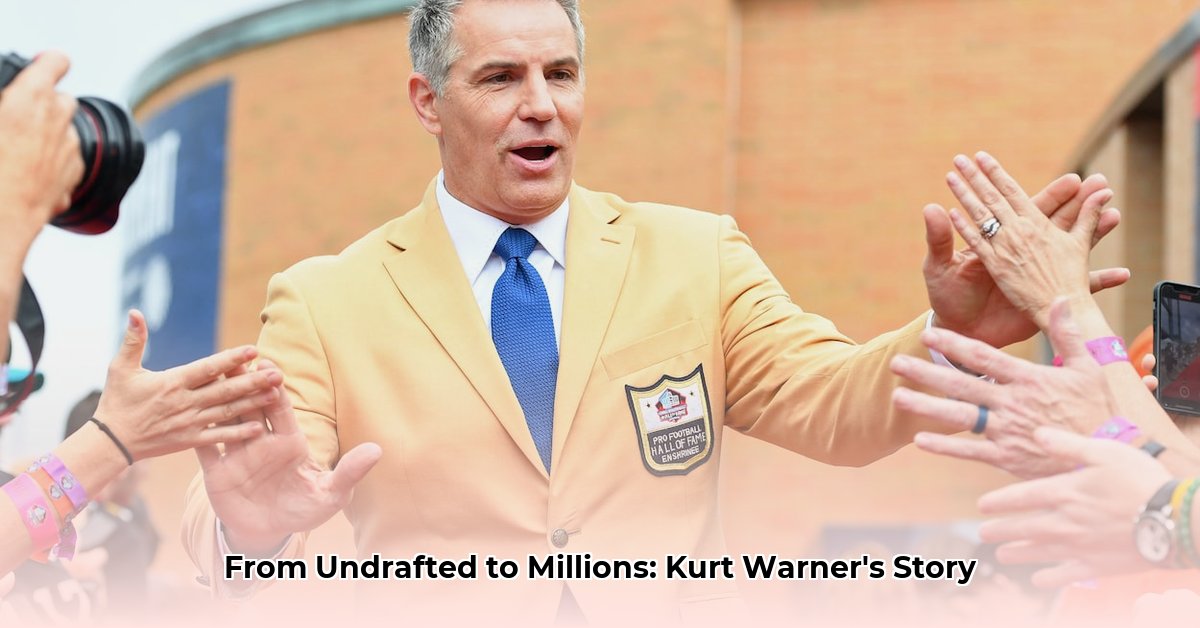
Kurt Warner's story transcends the gridiron; it's a testament to the American dream. From stocking shelves at a grocery store to becoming a Super Bowl champion and Hall of Famer, his journey culminated in an estimated $30 million net worth. But how did this undrafted quarterback amass such a fortune? It's a compelling narrative of hard work, strategic financial decisions, and seizing opportunities both on and off the field.
From Grocery Store Shelves to Gridiron Greatness: The Making of a Millionaire
Warner's NFL career (1998-2010) was nothing short of extraordinary. His rise wasn't preordained; he earned every inch of his success. Exceptional on-field performance translated into substantial earnings – his career salary likely exceeded $62 million. Accolades like Super Bowl MVP and NFL MVP significantly amplified his market value, attracting lucrative contracts. His $47 million contract with the Rams exemplifies the reward for exceptional talent. But Warner's financial acumen extended beyond contract negotiations. He made shrewd investments, including real estate, further bolstering his wealth. For instance, the sale of one of his homes for $2.5 million showcases this success. How impactful were these real estate investments on his overall net worth? Only detailed financial records would reveal the full extent.
Beyond Touchdowns: Endorsements, Broadcasting, and Building a Brand
Warner's financial success isn't solely attributed to his NFL career. His "underdog" story—a compelling narrative of overcoming long odds—proved incredibly marketable, attracting numerous endorsements that substantially increased his wealth. Post-retirement, he seamlessly transitioned into broadcasting, demonstrating foresight and financial planning prowess. This strategic move created multiple income streams, showcasing his financial acumen. He didn't just rely on football; he cultivated a brand that resonates far beyond the playing field. Indeed, this diversification is a key lesson from his success. What percentage of his total income came from endorsements after he retired from the NFL? That would be insightful data to analyze.
The Kurt Warner Financial Playbook: Lessons for Success
Warner's journey offers invaluable financial lessons:
Diversification: Warner didn't rely solely on his NFL salary; he diversified into endorsements and broadcasting, mitigating risk and creating multiple income streams. This strategy is crucial for long-term financial security.
Long-Term Vision: Warner planned for life after football, securing a sustainable financial future. This foresight is a key component of his financial success.
Strategic Investing: Shrewd investments, particularly in real estate, demonstrate his financial savvy and commitment to long-term growth. What other investment vehicles did he likely use? Analyzing his investment portfolio could offer further insight.
How to Build a Diversified Investment Portfolio Like Kurt Warner
Warner's journey underscores the importance of a diversified investment strategy. His approach likely involved calculated risk-taking and a long-term perspective. The key elements of his approach likely included:
Stocks: Both individual stocks and index funds (which track market performance) provided potential for growth.
Bonds: To balance riskier stock investments, providing stability and consistent income.
Real Estate: Tangible assets offered potential appreciation and rental income.
Alternative Investments: Potentially including higher-risk, higher-reward options.
Key Takeaways:
- Diversification across multiple asset classes is paramount.
- A balanced investment approach mitigates risk.
- Long-term planning is essential for wealth building.
- Professional financial advice enhances the effectiveness of strategy.
- Regular portfolio rebalancing ensures alignment with evolving circumstances.
Step-by-Step Guide: Building Your Portfolio
- Assess your risk tolerance: How much potential loss can you tolerate?
- Define your financial goals: What are your savings targets (e.g., retirement, down payment)?
- Determine your investment horizon: How long will your money be invested?
- Allocate your assets: Distribute investment funds among asset classes.
- Select investments: Choose investments aligning with your asset allocation.
- Monitor and rebalance: Regularly review your portfolio and rebalance to maintain your target allocation.